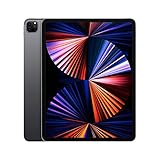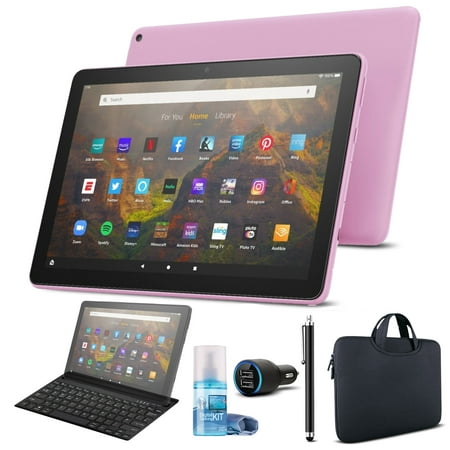As the use of technology in education continues to grow, more and more college students are turning to tablets as a way to stay organized, take notes, and access course materials.
Tablets offer several benefits for college students, including their portability, versatility, and ease of use.
Types of Tablets For Students
College life is a juggling act between academics, extracurriculars, social engagements, and perhaps even a part-time job.
To help balance this circus act, a tablet can be your best friend. But which one is right for you? Let’s walk through the types of tablets available and discuss how they can be leveraged for your college life.
iPads: The Creative’s Best Friend
When it comes to creativity, iPads are essentially the Swiss Army knives for college students in graphic design, digital art, video editing, or even video calling.
Let’s delve into the top three iPads that are best suited for these creative endeavours.
iPad Pro (12.9-inch, 5th generation)
Why it Rocks:
- Display: The Liquid Retina XDR display makes it ideal for graphic design, offering unmatched colour accuracy.
- Performance: With the M1 chip, it’s a beast that can handle even the most complex tasks in Adobe Illustrator and Procreate.
- ProMotion Technology: With a refresh rate of up to 120Hz, digital artistry feels incredibly smooth.
iPad Air (4th generation)
Why it Rocks:
- Performance: Though not as powerful as the iPad Pro, the A14 Bionic chip is no slouch and can handle most creative tasks.
- USB-C Port: Simplifies the process of transferring large video files.
- Apple Pencil 2nd Gen Support: Provides excellent stylus support for fine control in digital art.
iPad Mini (6th generation)
Why it Rocks:
- Portability: Its smaller size makes it highly portable, perfect for students always on the move.
- Performance: The A15 Bionic chip, performs admirably in tasks like basic graphic design and video editing.
- Apple Pencil 2nd Gen Support: Despite its size, it offers stylus support for those quick doodles and edits.
Comparison Table:
| iPad Model | Best For | Key Features |
| iPad Pro 12.9″ (5th Gen) | High-End Creative Tasks | M1 Chip, Liquid Retina XDR, ProMotion |
| iPad Air (4th Gen) | Mid-Level Creative Tasks | A14 Bionic, USB-C, Apple Pencil 2 Support |
| iPad Mini (6th Gen) | On-the-Go Creative Tasks | A15 Bionic, Portability, Apple Pencil 2 Support |
Usage:
- Graphic Design: With apps like Adobe Illustrator and Procreate, iPads are the go-to device for graphic design students.
- Digital Art: Stylus support allows fine control for digital artistry.
- Video Editing: Programs like iMovie are optimized for iPad.
Android Tablets: The Budget-Conscious Choice
Android tablets are the unsung heroes for budget-conscious college students. Whether it’s reading, everyday tasks, or multimedia, Android has got your back.
So, let’s check out the Android tablets that offer the best bang for your buck.
Samsung Galaxy Tab S7+
Why it’s Stellar:
- Display: The 12.4-inch Super AMOLED display makes academic papers and textbooks look crisp.
- Performance: Powered by Snapdragon 865+, it can multitask like a pro.
- S Pen Included: Ideal for taking notes and even some light sketching.
Lenovo Tab P11 Pro
Why it’s Stellar:
- Display: With an 11.5-inch OLED screen, it’s great for reading and research.
- Battery Life: Lasts up to 15 hours, ideal for long study sessions.
- Expandable Storage: Need more room for movies and music? Just pop in a microSD card.
Amazon Fire HD 10
Why it’s Stellar:
- Affordable: It’s a budget-friendly choice that doesn’t skimp on essential features.
- Performance: Good enough for everyday tasks like web browsing and note-taking.
- Amazon Ecosystem: Seamless integration with Amazon services makes it excellent for reading.
Comparison Table:
| Android Tablet | Best For | Key Features |
| Samsung Galaxy Tab S7+ | High-end Tasks | Snapdragon 865+, S Pen, Super AMOLED |
| Lenovo Tab P11 Pro | Balanced Performance | OLED Screen, 15-hour Battery, Expandable Storage |
| Amazon Fire HD 10 | Budget Choice | Affordable, Amazon Ecosystem, Everyday Performance |
Usage:
- Reading and Research: Great for devouring textbooks or academic papers thanks to a wide array of e-reader apps.
- Everyday Tasks: From taking notes to browsing the web, these tablets are good all-rounders.
- Multimedia: Most Android tablets support expandable storage, making them a hub for your movies and music.
Windows Tablets: The Power Users
When it comes to sheer computing power and versatility, Windows tablets are where it’s at. Forget your chunky laptops; these tablets offer comparable performance in a sleeker package.
Ideal for coding, heavy multitasking, and business software, here are the top picks for power users masquerading as college students.
Microsoft Surface Pro 7
Why it’s Stellar:
- Performance: Armed with 10th Gen Intel Core i7, it’s a coding powerhouse.
- Portability: Ultra-slim and lightweight, it’s perfect for students on the go.
- Full Windows OS: Run anything from Python scripts to PowerPoint with ease.
Lenovo ThinkPad X12 Detachable
You may want to have a tablet with a detachable keyboard for your routine tasks.
Why it’s Stellar:
- Battery Life: Up to 10 hours of unplugged productivity.
- Keyboard: Comes with a detachable ThinkPad keyboard, renowned for its tactile feedback.
- Security: Enhanced security features like fingerprint and facial recognition.
Dell Latitude 7320 Detachable
Why it’s Stellar:
- Performance: Equipped with an 11th Gen Intel Core i7 CPU for seamless multitasking.
- Display: A bright, 13-inch display makes for pleasant viewing while working on spreadsheets or presentations.
- Stylus Support: For when you need to scribble quick notes in a business lecture.
Comparison Table:
| Windows Tablet | Best For | Key Features |
| Microsoft Surface Pro 7 | All-around Use | 10th Gen Intel Core i7, Full Windows OS, Portability |
| Lenovo ThinkPad X12 Detachable | Security & Typing | 10-hour Battery, ThinkPad Keyboard, Enhanced Security |
| Dell Latitude 7320 Detachable | Business Software | 11th Gen Intel Core i7, 13-inch Display, Stylus Support |
Usage:
- Coding: With an actual desktop OS, Windows tablets are great for programming tasks.
- Heavy Multitasking: These can replace your laptop entirely.
- Business Software: Ideal for business students who need to use software like MS Office Suite or accounting programs.
Amazon Fire Tablets: For The Leisure Reader
Sometimes you just want a no-nonsense device to read, jot down lecture notes, and maybe binge-watch a series when the academic life gets you down. Enter Amazon Fire tablets, the paperback novels of the tablet world.
Amazon Fire HD 10 (2021)
Why It’s Stellar:
- Display: A crisp, 10.1-inch Full HD display makes reading academic journals less dreary.
- Battery Life: Up to 12 hours, perfect for long hours of study sessions.
- Storage: 32GB or 64GB internal storage, expandable up to 1TB with a microSD card.
Amazon Fire 7 (2019)
Why It’s Stellar:
- Portability: The 7-inch display means this tablet can fit into smaller bags effortlessly.
- Price: Extremely budget-friendly, leaving you more to spend on textbooks (or pizza).
- Alexa Integration: Who doesn’t want a virtual assistant for quick queries?
Amazon Fire HD 8 Plus (2020)
Why It’s Stellar:
- Performance: 3GB RAM and 2.0 GHz quad-core processor for smooth multitasking.
- Wireless Charging: Just plop it down on a Qi-compatible mat.
- Sound: Dolby Atmos audio makes those study playlists and podcasts come alive.
Comparison Table:
| Amazon Fire Tablet | Best For | Key Features |
| Fire HD 10 (2021) | Reading | 10.1-inch FHD, Up to 12-hour Battery, Expandable Storage |
| Fire 7 (2019) | Portability | 7-inch Display, Budget-friendly, Alexa Integrated |
| Fire HD 8 Plus (2020) | Multimedia | 3GB RAM, Wireless Charging, Dolby Atmos Audio |
Usage:
- Reading: These tablets are tailor-made for consuming books, especially if you’re already locked into the Amazon ecosystem.
- Basic Note-taking: Useful for jotting down quick notes during lectures.
- Entertainment: With the Amazon Prime ecosystem, you’ve got movies and music at your fingertips.
Chrome OS Tablets: The Online Scholar
You’re wedded to Google Drive like peanut butter is to jelly. You want something that’s robust enough for those late-night research sprees but won’t require you to hock a kidney.
The Chrome OS tablets are your cloud-computing dreamboats, adept at running Google’s suite of apps and optimized for all your web-browsing exploits.
Lenovo Chromebook Duet
Why It’s Stellar:
- Detachable Keyboard: Transform from tablet to laptop in a snap.
- Battery Life: A robust 10 hours to keep you unplugged and focused.
- Affordability: Unbeatable value that won’t break the bank.
HP Chromebook x2
Why It’s Stellar:
- High-Resolution Display: With a 2400×1600 pixel display, reading academic papers will be a breeze.
- Stylus Included: HP Active Pen lets you take your note-taking game to the next level.
- Strong Performance: The Intel Core m3 processor ensures smooth multitasking.
Samsung Galaxy Chromebook
Why It’s Stellar:
- Fiery Red Design: Make a statement while you study.
- AMOLED Display: Feast your eyes on a stunning screen.
- Powerful Specs: A 10th-generation Intel Core i5 CPU and 256GB SSD make this a speed demon.
Comparison Table:
| Chrome OS Tablet | Best For | Key Features |
| Lenovo Chromebook Duet | Versatility | Detachable Keyboard, 10-hour Battery, Affordable |
| HP Chromebook x2 | Note-taking | 2400×1600 Display, HP Active Pen, Intel Core m3 |
| Samsung Galaxy Chromebook | High Performance | Fiery Red, AMOLED Display, 10th gen Intel Core i5, 256GB SSD |
Usage:
- Cloud-Based Work: Great if your tasks primarily involve Google’s suite of applications.
- Web Browsing: Optimized for online use, making research a breeze.
- Budget-Friendly: Generally more affordable and good for students who are tight on cash.
Specialty Tablets: Niche Markets
Usage:
- Rugged Tablets: For those in environmental sciences who may need a durable option for fieldwork.
- Drawing Tablets: Specialized tablets designed purely for artistic endeavours.
- Medical Tablets: For healthcare students, these tablets are built to comply with medical standards for data security and integrity.
Comparison Table:
| Type | Best For | Notable Features |
| iPad | Creative Tasks | Stylus Support |
| Android | General Use | Expandable Storage |
| Windows | Power Users | Full Desktop OS |
| Amazon Fire | Reading and Entertainment | Budget-Friendly |
| Chrome OS | Online Tasks | Cloud Integration |
| Specialty | Niche Needs | Specialized Features |
How to choose the best tablet for college students:
Price: The price of a tablet can range from a few hundred dollars to several thousand dollars. It is important to set a budget before you start shopping for a tablet.
Size: The size of a tablet can range from 7 inches to 12 inches. The size of the tablet that you choose will depend on your personal preference and how you plan to use the tablet.
Weight: The weight of a tablet can range from a few ounces to a few pounds. The weight of the tablet that you choose will also depend on your personal preference and how you plan to use the tablet.
Battery life: The battery life of a tablet can range from a few hours to a few days. The battery life of the tablet that you choose will depend on how you plan to use the tablet.
Features: The features that are available on a tablet can vary greatly from one model to another. Some of the most common features that are available on tablets include a touchscreen display, a camera, a microphone, and speakers.
Troubleshooting common tablet problems
Tablets are powerful and versatile devices, but they can also be prone to problems. Here are some common tablet problems and how to troubleshoot them:
- The tablet is not turning on. If your tablet is not turning on, there are a few things you can check:
- Make sure that the battery is charged.
- Try pressing and holding the power button for a few seconds.
- If the tablet is still not turning on, you may need to reset it. To do this, press and hold the power button and the volume down button at the same time until you see the Android logo.
- The tablet is frozen. If your tablet is frozen, there are a few things you can try:
- Press and hold the power button for a few seconds to force a restart.
- Try pressing and holding the power button and the volume down button at the same time until you see the Android logo.
- If the tablet is still frozen, you may need to factory reset it. To do this, go to Settings > System > Reset > Factory data reset.
- The tablet is not connecting to Wi-Fi. If your tablet is not connecting to Wi-Fi, there are a few things you can check:
- Make sure that you are in the range of a Wi-Fi network.
- Check to see if your Wi-Fi password is correct.
- Try restarting your tablet and your router.
- If the problem persists, you may need to contact your internet service provider.
- The tablet is not connecting to Bluetooth. If your tablet is not connecting to Bluetooth, there are a few things you can check:
- Make sure that your Bluetooth device is turned on.
- Check to see if your Bluetooth device is discoverable.
- Try restarting your tablet and your Bluetooth device.
- If the problem persists, you may need to reset your Bluetooth settings. To do this, go to Settings > Bluetooth > Advanced > Reset Bluetooth settings.
- The tablet is not charging. If your tablet is not charging, there are a few things you can check:
- Make sure that you are using the correct charger.
- Check to see if the charger is plugged in properly.
- Check the charging port, if it is loose.
- Try a different charger.
- If the problem persists, you may need to replace your battery.
Your Questions Answered
Do I really need a tablet if I already have a laptop?
It offers portability and specialized functions like stylus support that laptops often lack.
Is an iPad better than an Android tablet?
It depends. iPads are generally more powerful but cost more. Android tablets offer flexibility and budget options.
What’s the minimum battery life I should consider?
Aim for at least 8 hours to ensure your tablet lasts through your classes.
Can I use a Windows tablet for coding?
Yes, they come with a desktop OS suitable for programming tasks.
How important is screen size?
Larger screens are better for multitasking but will be heavier. Choose based on your primary usage.
Conclusion
iPads are a dream for creatives. Got a tight budget but need versatility? Android’s your answer. If you’re a coding or business whiz, Windows tablets are your laptop substitute. Bookworms and Prime junkies, go Amazon Fire.
Chrome OS shines for those tethered to the Google ecosystem. And for unique academic needs—from fieldwork to medical data—speciality tablets have you covered. Ultimately, your choice comes down to your needs and budget. So, ready to up your college tech game?


























